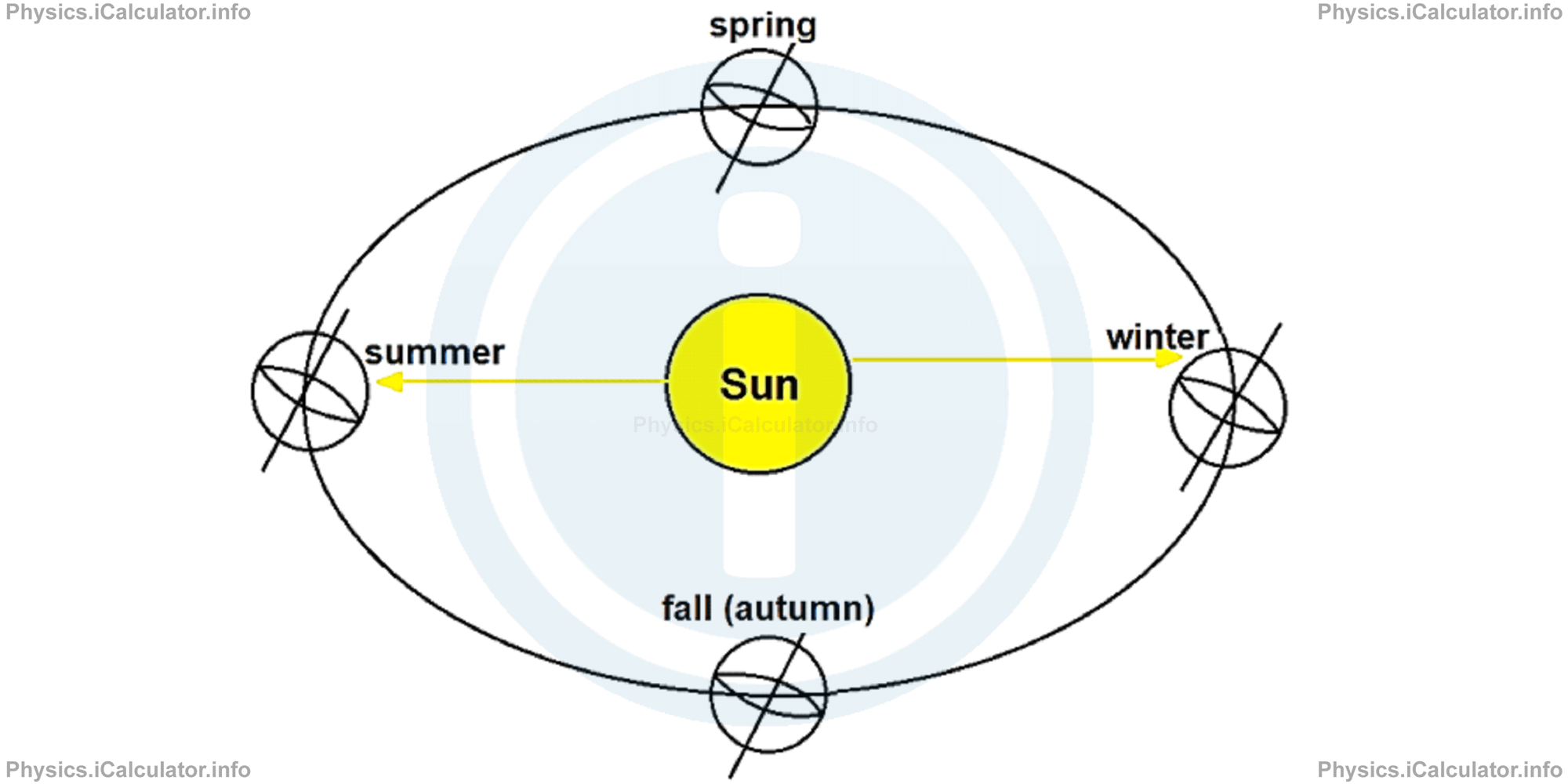Menu
Physics Lesson 22.2.9 - Seasons
Please provide a rating, it takes seconds and helps us to keep this resource free for all to use
Welcome to our Physics lesson on Seasons, this is the ninth lesson of our suite of physics lessons covering the topic of Sun and Planetary Motion, you can find links to the other lessons within this tutorial and access additional physics learning resources below this lesson.
Seasons
The phenomenon of seasons occurs because of the angle formed by the rotation axis of the Earth and the orbital plane (which is 23.45° as well). When this angle is taken in reference to the orbital plane, the value of inclination becomes 90° - 23.45° = 66.55°. This inclination makes the solar radiation fall at different angles on a specific point of Earth in various period of year. Since light intensity depends on the incidence angle, the solar energy brought to Earth is not the same throughout the year. It is greater when the incidence angle of solar radiation is closer to normal (vertical). This coincides to summer in any given location. On the other hand, when the incidence angle of solar radiation is the most deflected from normal (it is not so vertical), we have winter in that location. Look at the figure.

The Northern Hemisphere is taken as example to illustrate the season formation given that about 90 percent of the global population live in this hemisphere. Thus, in the left part of figure, sunrays fall almost normal to the surface of northern hemisphere. As a result, there is summer in that part of the Earth as more energy is coming from the Sun. On the other hand, there is winter on the right part of figure, as sunrays do not fall normal to the surface. They have the lowest angle possible in that part. Intermediate seasons such as spring and autumn are shown in the upper and lower part of figure, when sunrays fall at an angle that is in-between of the above angles.
The Southern hemisphere experiences the opposite phenomenon; people living in those areas have winter on June-July-August and summer on December-January-February. This is why Australians usually celebrate Christmas on the beach.
Solstice represents the time when the angle of incidence of sunrays on a region of the Earth is the lowest or the greatest possible. The day that this angle is the lowest, is the longest day of the year in that place, and the summer begins. In the northern hemisphere, this date corresponds to June 22nd of each year. On the other hand, winter solstice (the day when the angle of solar radiation incidence is the greatest) occurs on December 22nd in northern hemisphere - a day which corresponds to the beginning of winter and when the day is the shortest possible.
An Equinox occurs when the Earths' axis is deflected laterally only (not forwards or rearwards) in respect to the orbital plane. We have two equinoxes: in the northern hemisphere there is a spring equinox on March 2121 and autumn equinox on September 23rd. On these days, the duration of day and night are equal.
You have reached the end of Physics lesson 22.2.9 Seasons. There are 10 lessons in this physics tutorial covering Sun and Planetary Motion, you can access all the lessons from this tutorial below.
More Sun and Planetary Motion Lessons and Learning Resources
Whats next?
Enjoy the "Seasons" physics lesson? People who liked the "Sun and Planetary Motion lesson found the following resources useful:
- Seasons Feedback. Helps other - Leave a rating for this seasons (see below)
- Cosmology Physics tutorial: Sun and Planetary Motion. Read the Sun and Planetary Motion physics tutorial and build your physics knowledge of Cosmology
- Cosmology Revision Notes: Sun and Planetary Motion. Print the notes so you can revise the key points covered in the physics tutorial for Sun and Planetary Motion
- Cosmology Practice Questions: Sun and Planetary Motion. Test and improve your knowledge of Sun and Planetary Motion with example questins and answers
- Check your calculations for Cosmology questions with our excellent Cosmology calculators which contain full equations and calculations clearly displayed line by line. See the Cosmology Calculators by iCalculator™ below.
- Continuing learning cosmology - read our next physics tutorial: The Moon's Movement. Eclipses. Calendars
Help others Learning Physics just like you
Please provide a rating, it takes seconds and helps us to keep this resource free for all to use
We hope you found this Physics lesson "Sun and Planetary Motion" useful. If you did it would be great if you could spare the time to rate this physics lesson (simply click on the number of stars that match your assessment of this physics learning aide) and/or share on social media, this helps us identify popular tutorials and calculators and expand our free learning resources to support our users around the world have free access to expand their knowledge of physics and other disciplines.